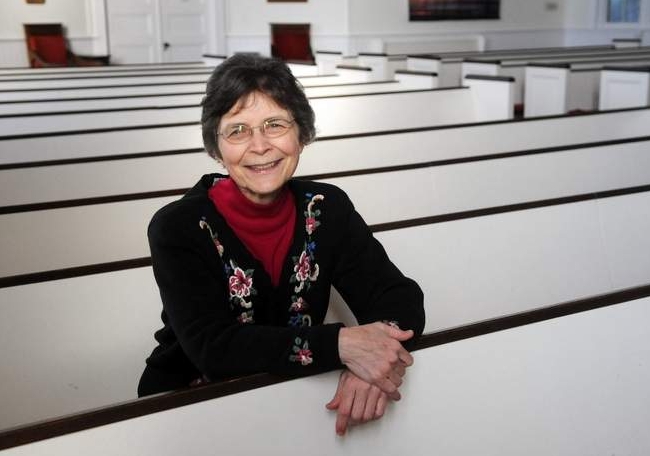By Max Sullivan
Hampton Union, January 15, 2016
[The following article is courtesy of the Hampton Union and Seacoast Online.]

Pastor Deb Knowlton of the First Congregational Church in Hampton wrote a book about the African Americans
living in Hampton who were part of the church in the 1700s. The book is called "Color Me Included: African
Americans of Hampton's First Church and Its Descendant Parishes 1670-1826." [Deb Cram photo]
HAMPTON – A new book tells the story of the African Americans who lived in the Hampton area during the 18th century, written by a local pastor intrigued with their lives documented in her church’s archives.
Deborah Knowlton, 65, pastor of the First Congregational Church on Winnacunnet Road, will release her new book, "Color Me Included: African Americans of Hampton’s First Church and Its Descendant Parishes 1670-1826,” next month through Peter Randall Publishing in Portsmouth. She’ll speak at 6:30 p.m., Feb. 16, at the Hampton Falls Library about the book.
Knowlton will also speak March 13 as part of the Portsmouth Black Heritage Trail and Seacoast African American Cultural Center's Elinor Williams Hooker Tea Talks Series at the Discover Portsmouth Center.
The book tells the true stories of 32 African Americans who were part of the church, as well as approximately 70 others who attended churches in surrounding communities like Hampton Falls and North Hampton. Most of the stories in the book occur between 1730 and 1776. Knowlton scoured her own church records, records at Hampton's Lane Memorial Library, surrounding town's records and records in Concord and Boston.
The project began when Knowlton researched records for information to be used for the church’s 375th anniversary in 2013. As she searched, she found records of baptisms and other church events starting around the 1730s included names of African Americans, records listing the word “black” next to their names.
Knowlton’s interest was grabbed even more when she read of one African American named Dinah. A minister had written in the archive that she was on her way to becoming a professor and was a good student of the scriptures.
“It meant she must have known how to read,” Knowlton said. “That kind of information that was there in the archival books in our history drawer, in the basement of the church, were pieces of information that got me intrigued to find out more about Dinah.”
Knowlton began compiling information on the names within the records and went to the Hampton Historical Society. There, society member and local historian Cheryl Lassiter told her to keep digging into the surrounding towns’ churches to get enough information for a book.
For Knowlton, the project was enlightening. She said she’d never given much consideration to what impact slavery had on New England before researching the book. Once she started writing, she realized slavery played a significant part in New England towns like Hampton. She learned even her own ancestor, a tenement owner in Portsmouth, owned slaves.
On one level, she said that sentiment is shocking.
“I grew up believing that the ‘problem of slavery’ was mostly a Southern problem that didn't touch my life in palpable, immediate ways,” Knowlton said via email. “I came to understand, myself, through writing this book, that slavery has no geographical bounds… I cannot deny that my ancestors, for the most part New Englanders, were complicit in a practice that I find detestable.”
By writing the book, Knowlton felt she was giving a voice to the lives of people who had until now remained practically forgotten.
“Originally, I mainly wanted to see if I could know anything about them,” Knowlton said. “To discover who an African American was, you have so few sources to look at because they never owned property, never voted, never got into primary positions in a community.”
One commonality among the African Americans in Hampton was how many had close relationships with their masters despite remaining slaves. Records show slaves usually slept in their master’s home, worked in the gardens side by side with them and sat in the same sleigh as their masters during the winter time. Despite that, African Americans still had a barrier to overcome as second class citizens.
“(Slave masters) did show immense kindness at moments in some of the stories I was able to find, and yet at the same time (it was) kindness that didn’t get to the point of a normalized relationship,” Knowlton said.
Knowlton said records show many of the African Americans in the Hampton area were determined to rise above slavery and racism. One free African American, Cesar Long, won three different lawsuits regarding money owed for caretaking services, including against the town of Hampton. One African American woman, according to the archives, refused to have children until she was free so her children could be born free.
“There were these incredible moments,” Knowlton said. “There were so many moments where I felt they really had pluck. They had courage. They had a sense of themselves despite all of the forces that could have taken that away from them.”
